List of HINDU GODDESS Names With Meaning | What is the name of the female Hindu goddess?
Namaste friends, how are you doing today? Welcome to #BhagavanBhakthi website / blog.
Bhagavan Lord Sri Vishnu (Krishna, Rama, Trivikrama, Narasimha, Vamana, Vasudeva, Mukunda) and Goddess Lakshmi (Rukmini, Satyabhama, Sita, Kamala, Maya) blessings to you and your family!
In this website / blog, you will always learn about #Hinduism #Sanskrit language.
Also subscribe to my YouTube channel from this link #BhagavanBhakthi to view videos about #Hinduism #Sanskrit language.
Just before going to “List of HINDU GODDESS Names With Meaning | What is the name of the female Hindu goddess?“, let us have a brief some brief information.
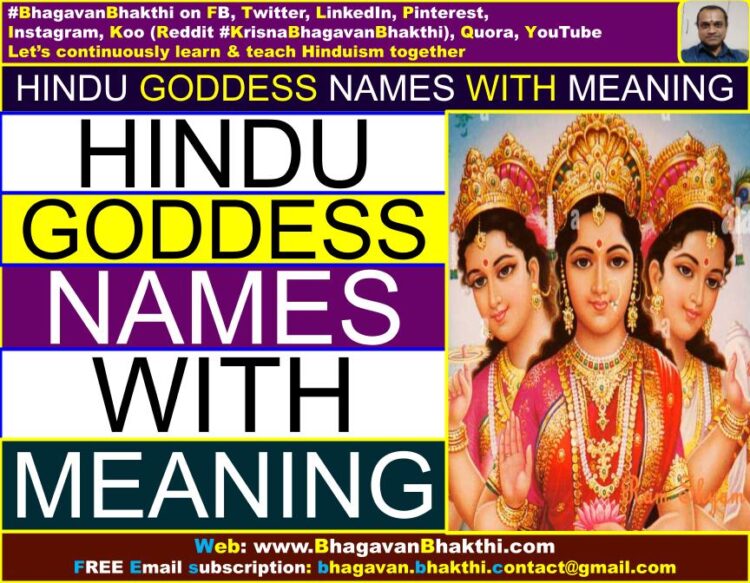
Hinduism or Sanatana Dharma is so old, that no one knows since how many years Sanatana Dharma is existing.
Sanatana Dharma means a Dharma which is eternal and also it is the original name for Hinduism used alongside the more common Hindu Dharma.
For every God starting from Bhagavan Sri Vishnu, Sri Brahma Deva, Sri Rudra Deva (Lord Shiva), etc. all have their consorts since the grand unknown time. No one exactly knows the exact date and time frame of their marriages.
We need to be highly proud to be born in this unique and greatest Dharma called Sanatana Dharma. No other Dharma has privilege of such a long and grand time frame.
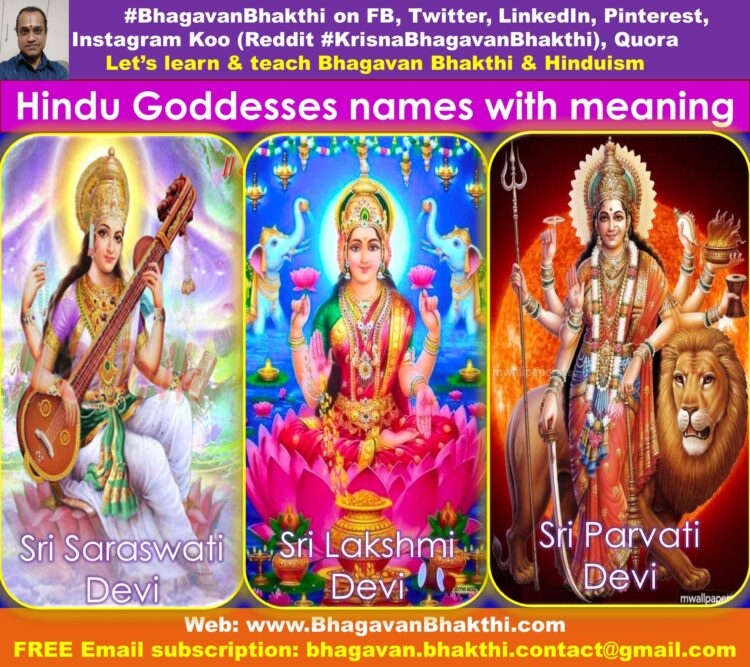
Now, let us know a long list of Hindu Goddesses names with meaning.
List of Hindu Goddess names with meaning:
Lakshmi : Lakshmi Devi is the consort of Bhagavan Sri Vishnu. She is the goddess of wealth, power, fortune, prosperity, etc. She is the first among the Tridevis (Three Goddesses). Second is Saraswati Devi and third is Parvati Devi.
In Sanskrit Lakshmi means someone who has some lakshya, that is, aim. Also Lakshmi means, she is the most ‘lakshana’, that is, she is the most beautiful after Bhagavan Sri Vishnu.
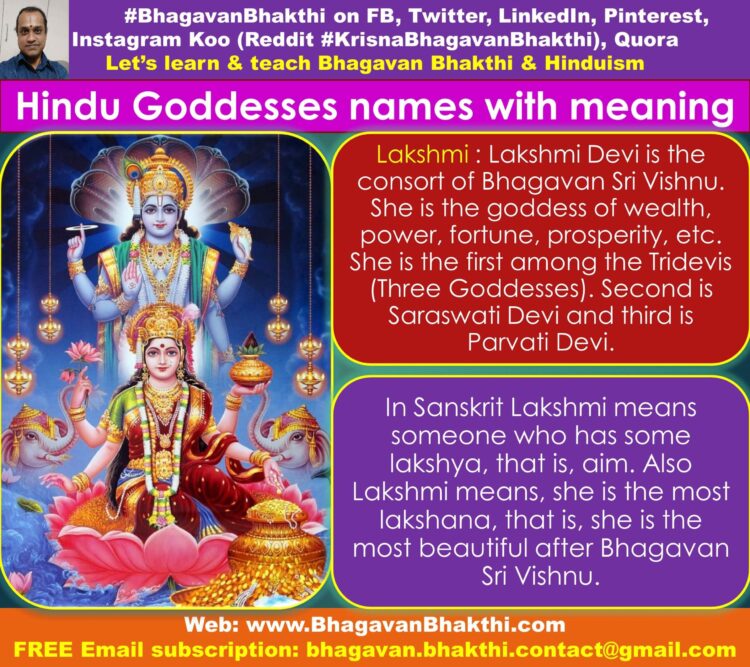
Adi Lakshmi : Here Adi means grant first. This form of Lakshmi Devi is the first form and thus the name Adi Lakshmi.
Dhanya Lakshmi : Here Dhanya (Dhaanya) means cereals. She is the main deity from whom we all get all the cereals (food).
Dhairya Lakshmi : Here Dhairya means courage. We all get dhairya (courage) from this form of Lakshmi Devi.
Gaja Lakshmi : Here Gaja means elephant, that is, she is the form of divine wealth. In Sanskrit gaja means huge divine wealth.
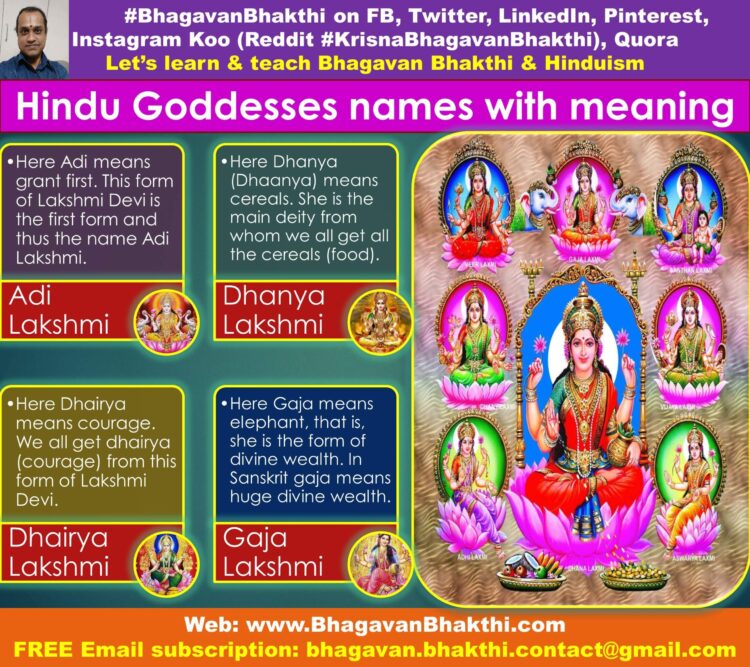
Santana Lakshmi : Here Santana means progeny. Santana Lakshmi is the main goddess who bless us with progeny.
Vijaya Lakshmi : Here Vijaya means victory. Only with her support and blessings, one can achieve the victory.
Vidya Lakshmi : Here Vidya means divine knowledge. Only with her blessings, one can get the divine knowledge and education.
Dhana Lakshmi : Here Dhana means satvika wealth. With her blessings, we can get different types of satvika wealth.
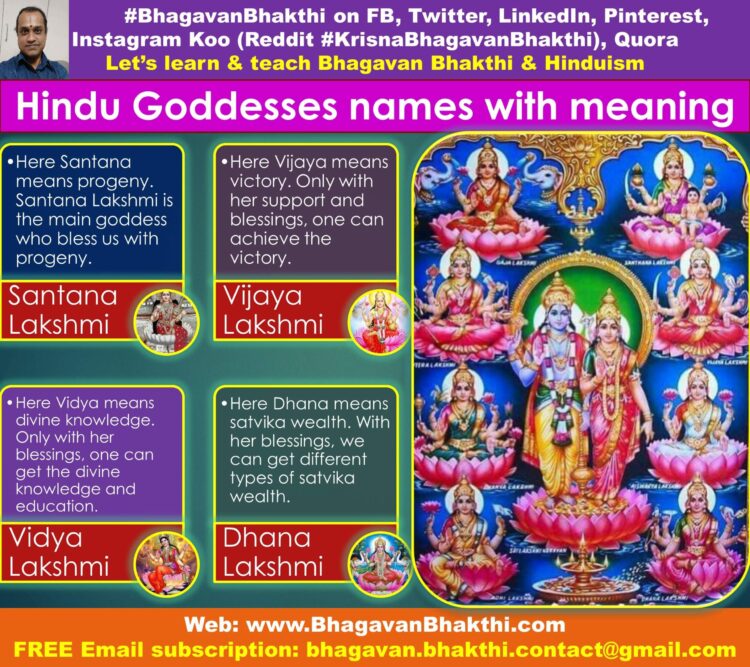
Saraswati : Saraswati Devi is the goddess of learning, education, knowledge, speech, music, art, wisdom etc. Only with her blessings one can achieve anything with respect to education and knowledge.
She is the main controlling deity (abhimani / tattvabhimani devata) of Vedas (education, knowledge, etc.). She is the consort of Sri Brahma Deva.
She is the second most prominent Goddesses among the Tridevis. First been Lakshmi Devi and third is Parvati Devi. She has different names like Sharada, Gayatri, Savitri, etc.
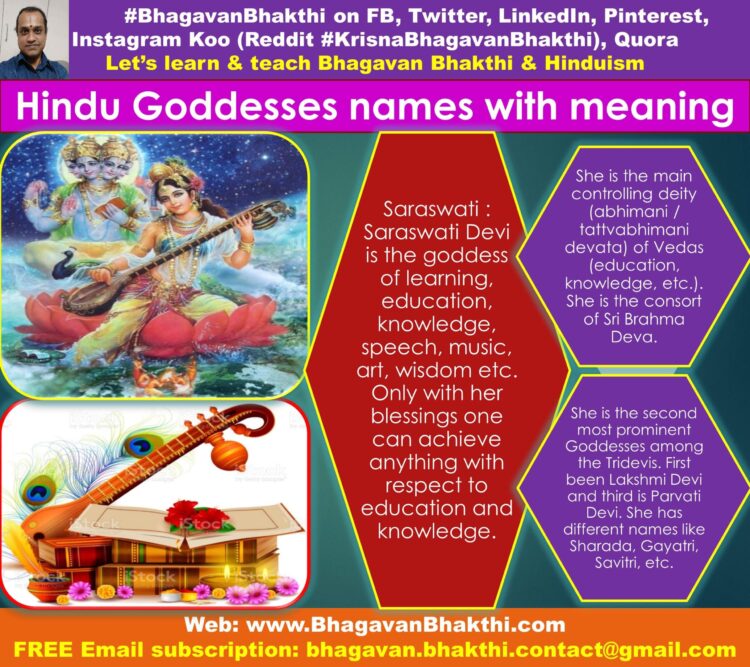
Bharati : Bharati Devi is the consort of Sri Vayu Deva. In the next Maha Kalpa Sri Vayu Deva will become Brahma Deva and his consort Sri Bharati Devi will become Sri Saraswati Devi. She has all the qualities of Sri Saraswati Devi.
Parvati : Sri Parvati Devi is the daughter of the Parvata Raja and thus the name Parvati. Parvati is the Goddess of love, fertility, marriage, children, beauty, harmony, etc.
She is the mother of Ganesha and Kartikeya. Her consort is Lord Shiva. She is the third most important Goddesses among the Tridevis. First been Sri Lakshmi Devi and second been Sri Saraswati Devi.
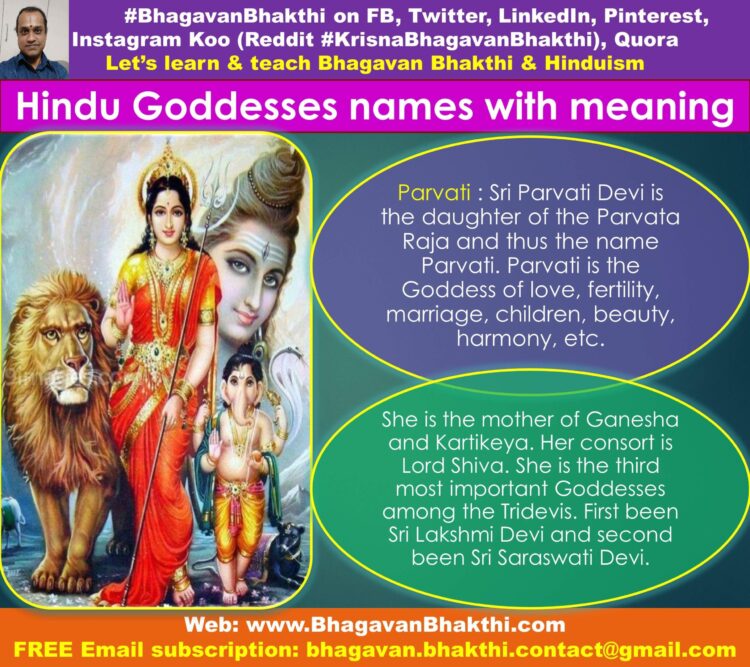
Durga : Sri Durga Devi is the different forms of Sri Maha Laskhmi Devi, Sri Saraswati Devi, Sri Bharati Devi and Sri Parvati Devi.
She is the one who destroys our ‘durguna’, that is, bad qualities and also she is the one who slays down all the ‘duracharis’, that is, who are ADharmis.
Different demons killed by Sri Durga Devi are Mahishasura, Chanda, Munda, Shumbha, Nishumbha, etc.
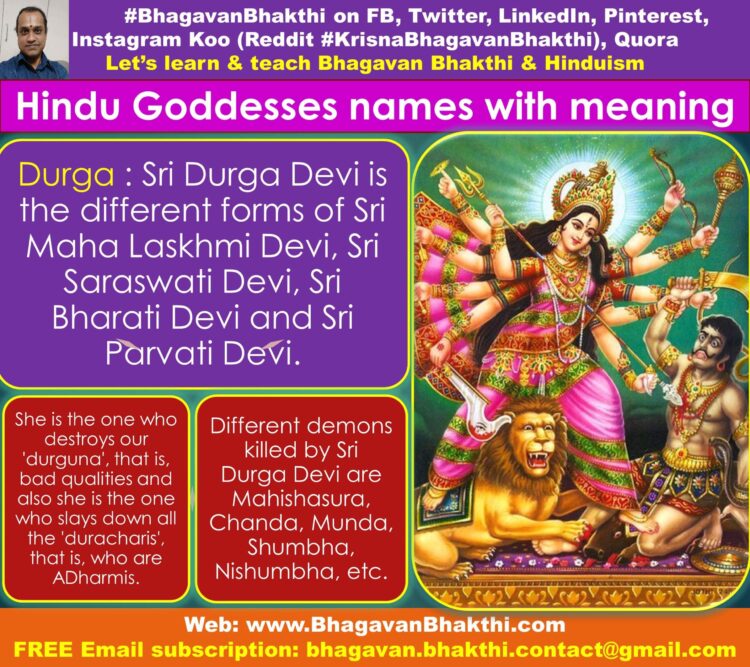
Bhumi : She is mother Earth. She has another name called as Prithvi. Bhumi or Mother Bhumi (Maata Bhumi) is also known as Bhudevi and Vasundhara, is the Goddess representing the Mother Earth.
She is the consort of Bhagavan Sri Varaha, an Incarnation of the Bhagavan Sri Vishnu. For this reason, Bhagavan Sri Varaha is also known as Bhagavan Sri BhuVaraha Swamy, and on the other hand Bhumi is also known as Varahi (Consort of Varaha).
Bhudevi is the mother of Narakasura and Mangala. Goddess Sita Devi’s mother is Bhudevi. Since Sita Devi is found while furrowing, Sita Devi is considered as the daughter of Bhumi and thus Sita Devi is also called as Bhumija.
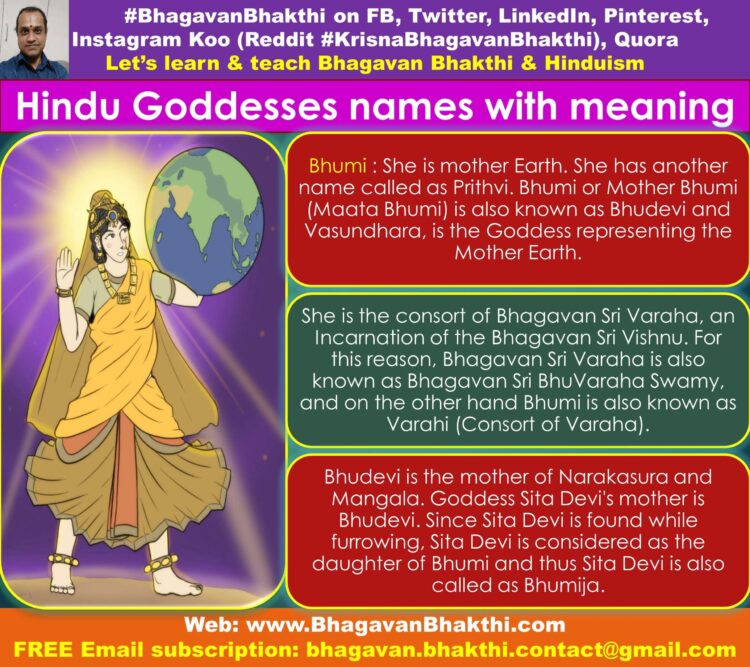
Varuni : She is pronounced as Sri Vaaruni Devi. She is the consort of Sri Aadi Shesha Naga (Bed of Bhagavan Sri Vishnu).
[Note: Some people consider her as the consort of Sri Varuna Deva. This is incorrect. Sri Varuna Deva’s consort name is Sri Ganga Devi (Ganges)].
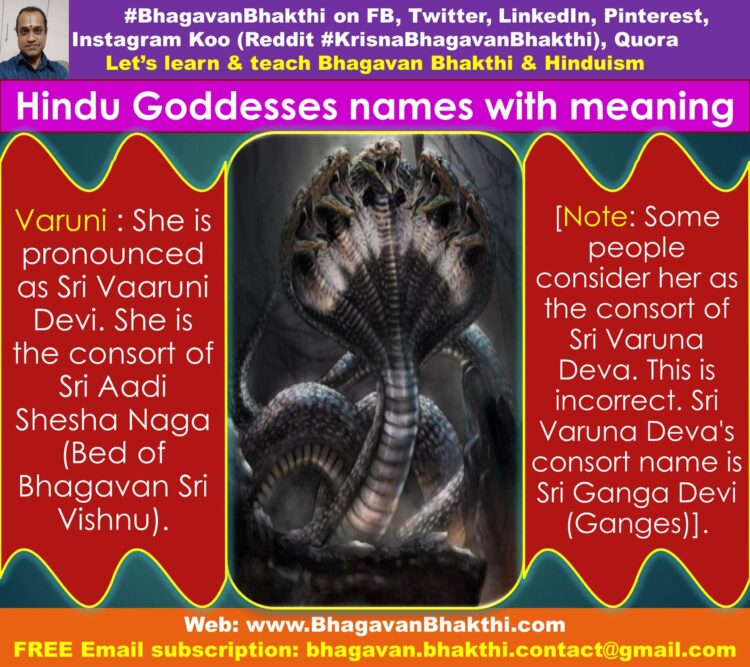
Sauparni : Sri Sauparni Devi is the consort of Sri Garuda Deva. He is the mount (vehicle) of Bhagavan Sri Vishnu.
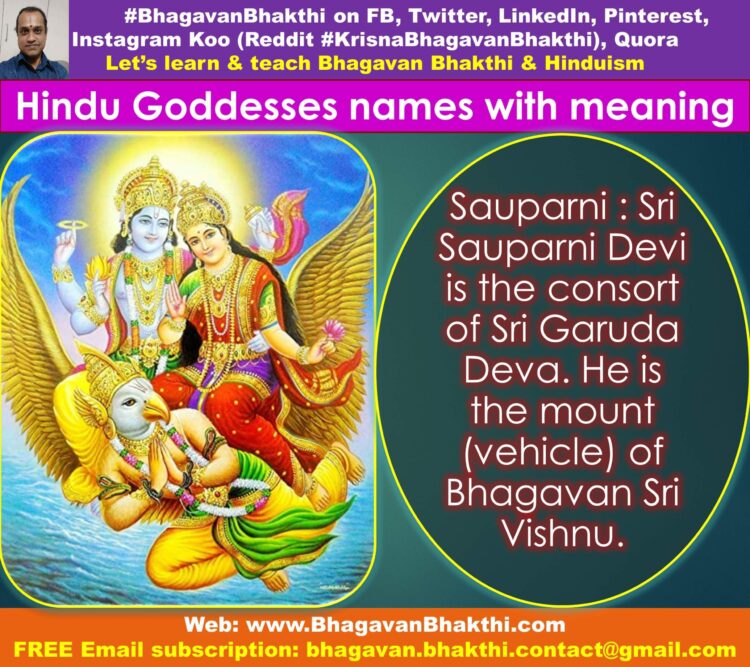
Sachi : Sri Sachi Devi is the consort of Sri Indra Deva. She is the daughter of Puloman (a demon). Her other names are Indrani, Aindri, Poulomi. Her children names are Jayanta, Rishabha, Midhusha, Jayanti, Devasena.
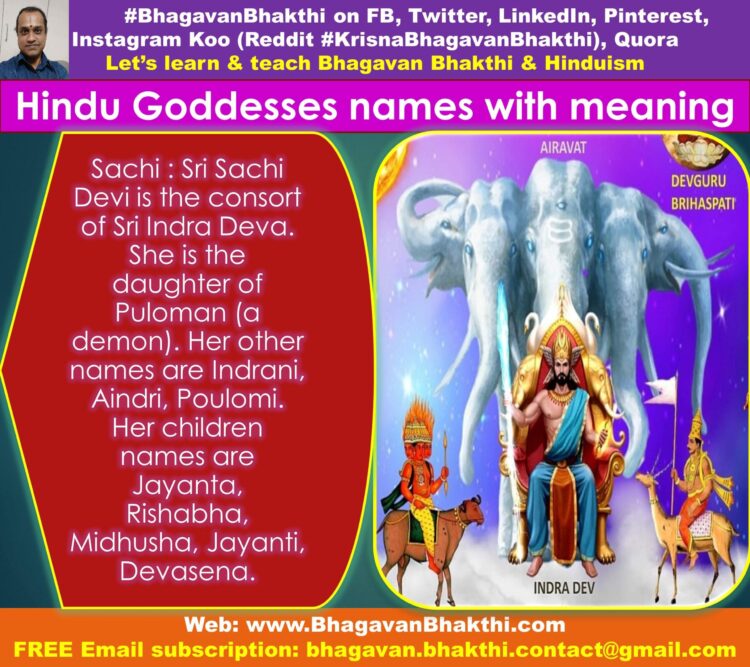
Rati : Sri Rati Devi is the consort of Sri Kama Deva (Manmatha). Sri Rati Devi is the goddess of lust, desire, love, passion, sexual pleasure etc. She is the daughter of Prajapati Daksha.
Sri Rati Devi is a constant companion of Sri Kama Deva (Manmatha) and she is often depicted with him in legend and temple sculpture. She is always worshipped alongside Sri Kama Deva. Without Sri Kama Deva and Sri Rati Devi blessings one can’t have the progeny.
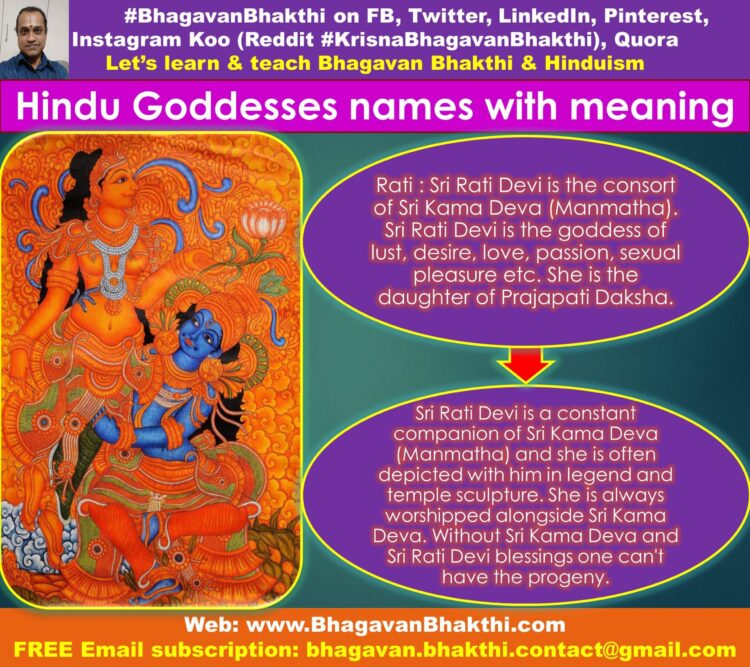
Tulasi (Tulsi) : Sri Tulasi Devi is the avatar of Sri Mahalakshmi Devi. During Samudra Manthana (churning of ocean), Bhagavan Sri Vishnu came in the form of Bhagavan Sri Dhanvantari. He is the vaidya roopa (Form of Physician) of Bhagavan Sri Vishnu.
Bhagavan Sri Dhanvantari came holding a ‘Suvarna Kalasha’ (Golden Kalasha / pot) comprising of Amrita from the ocean. At that time ‘ananda ashru’ (Eye drops / आनंद अश्रु) came out of Bhagava Sri Dhanvantari and this drops turned out to be Tulasi Devi.
It was on Kartika month, full moon day Sri Tulasi Devi took birth in the early morning. As soon as she was born, Sri Tulasi Devi went to the mountainous region of Badari to perform tapas / penance.
Though many people tried to persuade her, no one was able to do so, as she was determined to stay and pray in the forest till Bhagavan Sri Krishna appeared and agreed to become her consort.
Rivers names are as given below:
Ganga : “Ganga” is most shreshta / supreme or the best among all the rivers as it has come out of the “paadakamala” (Lotus feet) of Bhagavan Sri Maha Vishnu.
There is extra saannidya (presence) of Bhagavan Sri Maha Vishnu in Sri Ganga Devi.
When Sri Trivikrama roopi bhagavan touched the Brahmaanda kavaaTa with his right foot’s angusta / thumb finger, the shuddodaka came out of it and entered “satya loka” of Sri Chatur Mukha Brahma Deva, who stored in his “kamandala” and did prakshalana on himself.
While other rivers flows in bhooloka only, Sri Ganga Devi flows in all the triloka, and removes all sins, so she is the “shreshta nadi” (Best river).
Sri Ganga Devi flows in Badari, Hrishikesha, Haridwara and enters Bay of Bengal.
Even while doing snaana in ordinary water, we must have the nama smarana of Sri Ganga Devi and the sannidhana of Sri Ganga Devi can be brought there.
When doing snaana in well, sarovara, pushkarini, and rivers we have to give arGya to Bhagavan Sri Maha Vishnu, Sri Ganga Devi and Sri Surya Deva apart from the respective theerthabhimani devatagan.
But while doing snaana in Sri Ganga Devi river, we must give arGya to Bhagavan Sri Maha Vishnu, Sri Surya Deva, Sri Ganga Devi only and not to other theerthabhimani devatagan.
To know about the Greatness of Sri Ganga Devi, you visit my other post. The link for the same is as given here: What is the greatness of Ganga
Godavari : Godavari comes next to Ganga in shreshttatva. This is one among the “sapta mahanadi”. Godavari’s birth place is Tryambaka parvata near Nasika.
It flows upto Rajamahendri. “Nadee Taratamya Stotra” by Raghavendra Tirtharu says “Shanmaasa phaladaa gOdaa” meaning the snaana phala from Godavari will be there for six months.
Krishnaveni : Krishnaveni is the sangama / uniting of “Krishna” and “Veni”. She borns in Sahyaadri.
Swami Pushkarini : Swami Pushkarini, Chandrapushkarini and Manasa Sarovara are equal to “Krishnaveni”.
It is in Bhoovaikunta, that is in Tirupathi, where Bhagavan Sri Maha Vishnu has kept his sannidhana through Sri Varaha Svami and Sri Srinivasa roopas.
There are several theerthaas, one among them is Swami Pushkarni Tirtha – where it is said that
While doing snaana in Swamipushkarini, we must have the dhyana as “Bhagavan Sri Maha Vishnu will be standing with Sridevi-Bhoodevi, holding his Shanka, Chakra, and varadamudra.
Chandra Pushkarini : It is a sarovara, which can be found in the fifth praakaara among sapta praakaraas at Sri Ranga.
It is believed that Chandra did penance at this place for more than thousand years as per Sri Vadirajaru in Theerthaprabandha
Manasa sarovara : This is in Himalaya mountain range, which has the special saannidhya of many Devatagan. Kaveri and Saraswathi – Both these rivers are in the same kakshya.
Kaveri : It takes its birth in Bhagamandala Talakaveri. She was earlier Agastya Maharshi’s wife Lopamudra and now born as daughter of “Kavera” Rushi – that is “Kaveri”.
In Sri Rangam, Kaveri flows in two directions. We can find Kaveri in all the Ranga kshetraas viz., Aadiranga – Srirangapatna, Madhyaranga – Shivanasamudra and Antyaranga – Sri Ranga.
In all these places Bhagavan Sri Maha Vishnu is in the roopa of Ranganatha Svami itself.
Saraswati (river) : It flows from Himalaya near Shamyapraasa, where there is Vyasashrama in Badari.
In “Prayaga” Sarasvati flows as Guptagamini, along with Ganga and Yamuna – so it is called as Triveni sangama (uniting of the three rivers).
Sarayu : This flows in Ayodhya, that is in Sri Rama janma bhoomi. This is in the kakshya next to Kaveri and Saraswati.
Tungabhadra : “Tungabhadra” and “Sarayoo” both are in the same kakshya. Tunga & Bhadra are born from the teeth of “Sri Varaha Svami” and joins in Koodli near Shivamogga and flows in Honnali, Mantralaya, etc.
There is a saying “gangaa snaanam tungaa paanam”, meaning the Tunga river is very very tasty.
Yamuna or Kalindi : Yamuna river comes next to Tungabhadra. She is the daughter of Sri Surya Deva from Sanjya Devi and the sister of Sri Yama Deva. This is also one among the sapta mahanadees.
Yamunotri is the janma staana of this river. As this river flows in Kalinda parvata ranges, it is called as “Kalindi” and Bhagavan Sri Krishna did the Kalinga mardhana in this river itself.
Narmada – Sindu : Next to Yamuna in taratamya – comes Narmada which takes birth in Vindyaparvata and Sindhu River.
To know the greatness of Narmada river, you can visit this link: What is the greatness of river Narmada
Bhavanaashini : It flows in Ahobila which is the capital of Hiranyakashipu and it is Nava Naarasimha kshetra.
Next to Bhavanashini comes “Kumudhvati”:
Next to Kumudwati comes “Malaapaha” : This removes daihika and maanasika kalmasha in us.
Next to Malaapaha comes “Taamraparni”, “Bheemarati”, “Manjula” and “Pinakini” which are equal in Kakshya.
Tamraparni : This flows in Tirunelveli in Tamilnadu.
Bheemarati : This flows in Pandarapura in Maharastra which is also called as Chandrabhaaga.
Pinakini : This flows as two channels that is, Dakshina Pinakini and Uttara Pinakini, which is said to be the birth place of Trivikrama.
Next – Sagaragami Rivers : which flows independently and are equal to Bheemarati and joins the Sea.
Next – All other rivers
Next – Pushkarini : Which are usually found in the Eshaanya direction of the devastaanas.
Next – Sarovaraas
Next – Tataakaas : Which flows in villages, forests and mountain ranges in half chandrakruti.
Next – Devakhata
Next – Koopaas (wells) : Which is about 5 Feet width, created by digging earth and covered with Cement blocks (कुंआ).
Annapoorna : She is an avatar / form of Goddess Sri Parvati Devi. She is the Goddess of food. Here Annapoorna means, someone who feeds food full stomach. Anna + Poorna = Food + Full stomach.
Once, Lord Shiva cuts off the fifth head of Sri Brahma Deva. Thus Sri Brahma Deva curses Lord Shiva to be a ‘bhikshuka’. Also Lord Shiva has to use the fifth head of Sri Brahma Deva as the ‘kapala’ (vessel for begging).
Finally after a lots of efforts by Lord Shiva, Sri Annapoorna Devi puts the food into the ‘kapala’ and thus Lord Shiva becomes free of curse of Sri Brahma Deva.
Different names of Sri Annapoorna Devi are as given below:
a. Viśālākshī (विशालाक्षी) – She who has large eyes. | b. Viśvaśakti (विश्वशक्ति) – She is the power of world. | c. Viśvamātā (विश्वमाता) – She is the mother of the world. |
d. Sṛṣtihetukāvaradānī (सृष्टिहेतुकावरदानी) – She is the someone who is a boon granter for the sake of the world. |
e. Bhuvaneśvarī (भुवनेश्वरी) – She is the Goddess of earth. | f. Renu (रेणु) – She is the Goddess of Atom. | g. Annadā (Sanskrit: अन्नदा) – She is the donor of food. |
To know the full story of “What is Lord Brahma Deva fifth face real story”, click this link: What is Lord Brahma Dev fifth face real story
Sati : Sri Sati Devi was a daughter of Daksha Prajapati and thus she was also known as Dakshayani. Daksha Prajapati was not liking his son-in-law Lord Shiva.
One day, Daksha Prajapati arrange a yagna and had not invited Lord Shiva and Sri Sati Devi. But Sri Sati Devi insisted her husband Lord Shiva that she want to attend the yagna.
Later Daksha Prajapati due to his ego and arrogance, humiliates Lord Shiva. This was not tolerated by Sri Sati Devi and thus she enters into fire and sacrifices her life. Later she was again born as Parvati Devi as the daughter of Parvata Raja.
Siddhi and Buddhi : Both Siddhi and Buddhi are the consorts of Lord Ganesha. Siddhi means achieving spirituality and Buddhi means achieving intellectuality. Both are born from Sri Brahma Deva’s mind and thus they are known as ‘manasa putris’ (Daughters born from mind).
Shashti (Devasena) : She is the consort of Lord Kartikeya and she is the Goddess of children and reproduction. She is the daughter of Lord Indra Deva and Sachi Devi.
Svaha : She is the Goddess of ash and marriage, daughter of Daksha Prajapati and consort of Sri Agni Deva. In Sanskrit Svaha means invocation offering.
Svaha Devi and Sri Agni Devi have three sons and their names are Pāvaka (purifier), Pāvamāna (purifying) and Śuchi (purity). Svaha Devi’s father is Daksha Prajapati.
Dakshina : She is the Goddess of yagna and was born from the hair follicles of Radha Devi and also reborn from Goddess Sri Lakshmi Devi. She is the consort of Lord Yagna.
Navagrahas consorts
More information will be added to this on regular basis. Please this post and other posts of this website / blog to get the updated information.
To know more about Hindu Gods unknown facts, visit this link: Hindu Gods unknown facts
Dear friends, if you need any clarifications about this post, kindly let me know, I will definitely try to answer all of them.
Also your one LIKE, one COMMENT, One Share, one SUBSCRIPTION is highly important.
This will help to know the quality of this content and also it will be helpful to know if any improvements is required for the content.
If you feel this content is useful to you and has helped you to improve your knowledge, kindly share this with your well-wishers.
Because “SHARING MEANS CARING”.
To receive FREE EMAIL SUBSCRIPTION about #BhagavanBhakthi, you can send an email to bhagavan.bhakthi.contact@gmail.com from your email ID.
NAMASTE!
Sri Gurubhyo Namaha
Sri Krishnaaya Namaha
Sri Krishnaarpanamastu
Share in Social Media
Your point of view caught my eye and was very interesting. Thanks.